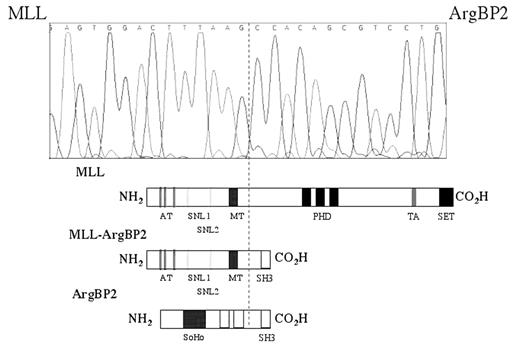Abstract
Rearrangement 11q23, involving MLL gene is mainly associated with M4/M5 acute myeloid leukemia (AML) and is characterized by poor prognosis and responsiveness to therapy. In this case blasts from an infant patient with monocytic AML were analyzed at diagnosis. The most frequent translocations of MLL, t(4;11) (40%, MLL-AF4) and t(9;11) (27%, MLL-AF9) were investigated by RT-PCR and resulted negative, meanwhile interphase FISH analysis, performed by using specific MLL probes, revealed a MLL gene translocation. Panhandle-PCR technique was performed to identify the partner gene and candidate clones DNA were sequenced to identify the unknown partner gene. The sequence analysis revealed the presence of a region of MLL connected with a region of ArgBP2 gene (chromosome band 4q35.1). The fusion gene is composed of the first 9 MLL exons and the last 3 ArgBP2 exons (exons 19–21) (Fig. 1). ArgBP2 belongs to vinexines family of protein adapters with three C-terminal SH3 domains, several potential phosphorilation sites for c-Abl and a serine/threonine rich region. The predicted fusion protein consists of AT-hooks and MT domains of MLL and the last ArgBP2 SH3 domain. MLL-ArgBP2 chimeric transcript was expressed in the blast while the reciprocal transcript ArgBP2-MLL was not. Identification of this new translocation of MLL gene confirms the high grade of MLL recombination in infant AMLs. Ongoing studies are in progress to analyze the mechanism leading to this new chromosomal translocation and the leukemogenic potentialities of the new MLL-ArgBP2 fusion protein.
Author notes
Corresponding author


This feature is available to Subscribers Only
Sign In or Create an Account Close Modal